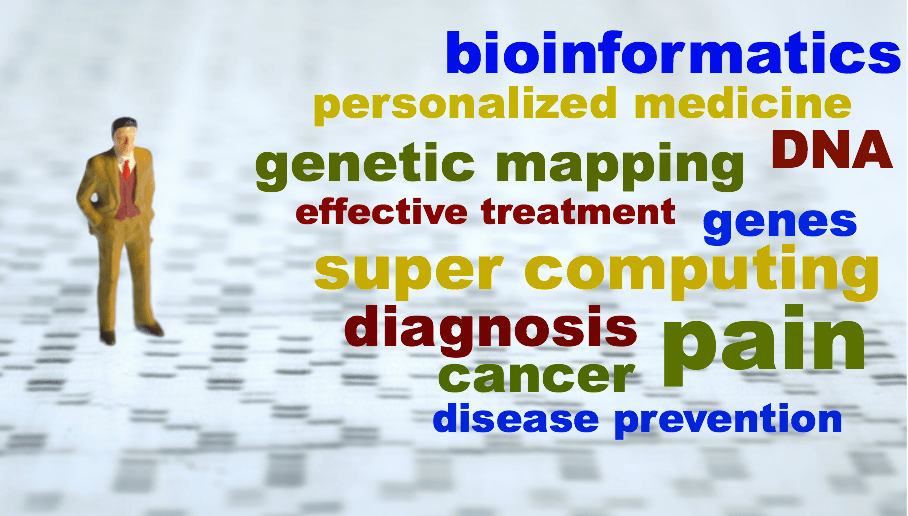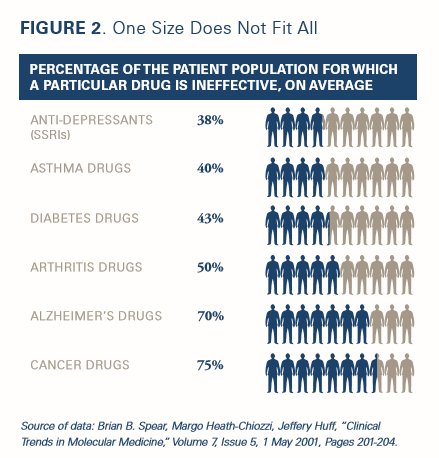Genetic Mapping + Super Computing = Personalized Medicine

Many people know of genetic mapping and may have even heard of the term “personalized medicine”. But the bridge from one to the other wouldn’t be possible without bioinformatics, which is less well known. Here’s the connection between all three – and why pain sufferers should be interested.
Let’s Start with Genetic Mapping

Genetic, gene or genome mapping all refers to the creation of a genetic map that assigns DNA fragments to genes. While the mapping capability has been around for many years, the Human Genome Project paved the way for scientists to begin offering genetic mapping on an individual basis. According to the National Human Genome Research Institute, genetic maps have been used successfully to find genes responsible for inherited disorders and also common disorders.
In the past, genetic mapping has been cost-prohibitive for most of the population to undertake. However, as more companies have entered the genetic mapping marketplace, the cost has declined significantly. Currently, full mapping for an individual costs between $1,000 and $4,000. Earlier this year, a leader in the industry announced plans to launch a $1,000 option – the lowest price to date. Whether one’s insurance pays for this or not, genetic mapping is finally an affordable option.
Then, You’ll Need a Really Big Computer…
The enormous amounts of data provided from genetic mapping require super computing capabilities in order for it to be of use. Enter bioinformatics, described as the science of managing and analyzing vast biological data with advanced computing techniques. Through computer science, math, statistics and engineering, bioinformatics helps scientists make or aid others in making medical discoveries and has an essential role in searching for unique genomic features, variations, and disease markers.
Primarily, bioinformatics increases the understanding of biological processes. What sets it apart from other approaches is its focus on developing and applying computationally intensive techniques to achieve this goal. At present, our ability to collect data outpaces the medical community’s ability to understand and act on it. The field of bioinformatics will help scientists to catch up.
Finally, The Connection to Personalized Medicine

We have the data – and the computing capabilities to store and analyze it – what’s next? Personalized medicine is an emerging practice of medicine that uses an individual’s genetic profile to guide decisions made in regard to the prevention, diagnosis, and treatment of disease. Knowledge of a patient’s genetic profile can help doctors select the optimal medication or therapy and administer it using the proper dose or regimen.
So let’s say you are a breast cancer patient, and your cancer is characterized by over-expression of a cell surface protein called human epidermal growth factor receptor 2 (HER2). You are one of about 30% of cancer patients with this protein.
For you, the standard therapy is not effective, but an antibody-drug called Herceptin® can reduce the recurrence of a tumor by 52 percent when used in combination with chemotherapy.
With genetic mapping and bioinformatics, scientists could conduct diagnostic tests to identify your HER2, and your doctor would know to recommend Herceptin® because it would personally benefit you.
The Future – and Hope for Pain Sufferers
Proponents of personalized medicine envision a future in which all individuals will have their full genomic sequence linked to their medical record. This, coupled with the analytic capabilities brought forth through bioinformatics, will give doctors more to work with than ever before – in both effective diagnostics and treatment of illness. While cancer is benefiting from these approaches, autoimmune illnesses are also experiencing great results. And these approaches are increasingly being used to help sufferers of many other pain-related conditions.
The future – where conditions are predicted before they occur, proactively treated and where patients receive a customized and more effective treatment approach – is at our doorstep. Personalized medicine and the data behind it have more potential now than ever before. Stay tuned, stay interested…and stay hopeful!
Additional reading:
Personalized medicine in orthopedics: http://www.avera.org/services/personalized-medicine/
Daily news on personalized medicine: http://www.sciencedaily.com/news/health_medicine/personalized_medicine/
Genetic testing in pain medicine: http://www.painmedicinenews.com/download/genetictesting_pmn0413_wm.pdf
PainPathways Magazine
PainPathways is the first, only and ultimate pain magazine. First published in spring 2008, PainPathways is the culmination of the vision of Richard L. Rauck, MD, to provide a shared resource for people living with and caring for others in pain. This quarterly resource not only provides in-depth information on current treatments, therapies and research studies but also connects people who live with pain, both personally and professionally.
View All By PainPathways






